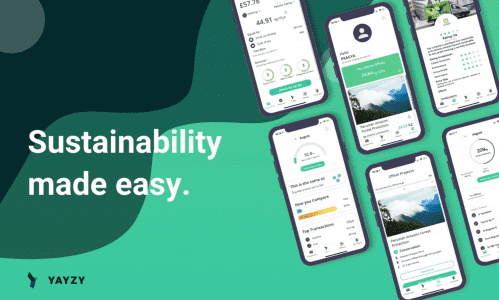Reduce Your Carbon Footprint: Seven Apps And Tools That Highlight Emissions - Dispatch Weekly
January 28, 2021 - Reading time: 9 minutes

Becoming more environmentally friendly and reducing people’s carbon footprint has become a hot topic in recent years. While the government is working on programmes that make us greener, individuals can do a lot to reduce their individual emissions.
However, some people still do not realise that what they do in their daily lives is problematic for the environment or that they are responsible for the harm caused.

Some will advise on whether what you eat is good for the planet or not, while others will tell you how much your holiday air miles damage the environment. To help you, there are now several apps and websites that tell us just this. We’ve examined seven of the best apps, websites and tools to help you understand the environmental impact when you spend your money and how to cut your carbon emissions today.
Launched in January 2021, this new app helps users see the impact on the environment when they spend their money. As users spend money, Yayzy shows them the carbon footprint of each purchase in real-time.
This can mean switching off a light bulb for 1000 hours, travelling 900 km in a small car, or showing users what to do with it when they buy a train ticket. “We want to close the gap that is stifling progress towards net-zero by empowering millions of people – the heroes of climate change,” said Mankaran Ahluwalia, CEO of Yayzy.
“We have a lot of equivalence and comparison to help users understand what their impact means,” said Mr Ahluwalia. The app asks users for their bank details to make up for the damage they have done, such as planting more trees or putting money into building a new wind farm. Anything weighing more than 400 kg will put you in the red, and the metre will represent the user’s carbon footprint.
It also shows the number of kilometres travelled in the car and the amount of carbon dioxide emissions per kilometre, to help users understand what their carbon footprint means. For example, if you weigh 253 kg, that equates to 1,645 km of travel and it would take about 4,071 days for these emissions to be absorbed by a tree. This would cause a total of 1.6 million tonnes of CO2 emissions over a year, as illustrated in this graphic from the US Environmental Protection Agency (EPA).
Energy is the biggest source of pollution for the average household. Most people know you can choose a 100% green tariff for your home energy, but there’re smart ways to go even greener with your energy and save enormous amounts of cash.
On Octopus’ ‘Agile’ tariff, electricity prices change every half an hour depending on the wholesale price of energy, connected to what proportion of the power in the UK is currently coming from renewable sources. This changes constantly, so your energy can have a much higher or lower carbon footprint depending on the time you use power most. Generally speaking, when the UK’s energy is greenest, and least polluting, the price is cheaper on the Agile tariff. Sometimes, when there’s a glut of green energy (like a really windy night) prices can even go negative so you can get paid small amounts of money to use up the leftover low-carbon power.
Octopus have made Agile open-source, so customers and other businesses can access the Agile price data via a public API and create simple, user-friendly apps and integrations to help people make the most of the cheapest, greenest energy. Octopus Watch is an unofficial app designed for customers on the tariff, showing them the Agile energy prices throughout the day – so they can easily avoid using energy when there’re more fossil fuels burning, and plan to use more energy when there’s lots of wind turbines spinning.
There’s even an Alexa integration using data from the energy grid, where you can ask Alexa how green the UK’s power is at any given moment, and when the greenest times of day to use power are. As our world gets smarter, and more of the UK’s power comes from green sources, shifting your energy consumption based on when the wind blows and the sun shines will become the norm. Agile means you can access this future today, and save loads of cash too.
This United Nations platform is designed to show users how much they can influence the environment. Users are asked to indicate how often they eat meat products, how much renewable energy they use and how often they fly abroad, among other things. It then calculates annual emissions roughly in line with both the UK and global average and estimates the impact of each.
For example, it turns out that up to half of the energy consumed by conventional light bulbs is wasted on heat generation. The United Nations supports users to offset their carbon consumption as long as there are accessible and effective climate actions, but without the support of their local government and other stakeholders, people cannot do so.
This app helps users automatically measure carbon dioxide emissions resulting from everyday decisions and gives tips on how to reduce them. The project also aims to eliminate the same amount of CO2 emissions caused by the burning of fossil fuels such as coal, oil and gas.
Users indicate how often they are on the road every day, what transport means to them and what they eat regularly. Other questions are also asked, such as how many flights you take in a year and how many trips you make.
The app gives the user their monthly carbon footprint and reveals how the result is made up, such as from transport, food and energy consumption. When you type in what you eat, where you travel and which direction you are travelling, the app tracks your daily emissions. The app also has tips and tricks to help you reduce your emissions throughout the day.
This app provides a calculator that shows users how many trees need to be planted to offset their carbon footprint, as well as the cost of each tree and its location.
Once the figure is calculated, users will have to answer questions about their habits, including travel and energy consumption. They are then moved to a page where they can choose how much they want to pay to offset their carbon footprint and the number of trees to be planted. Individuals and businesses can use the website for a variety of purposes, such as to help with business planning and even marketing campaigns.
Whether on foot, by car, by public transport or by bike, this practical website shows you how much emissions have been emitted during your journey and what they represent.
We hope that those who drive to work will see the value in using this data to take public transport or walk instead. You will see an estimate of the cost that your emissions impose on society, based on the social cost of carbon (source: American government data). Select the type of vehicle you are in – be it a van, taxi or car – to determine the emissions you emit on the road. The CO2 balance increases by up to 20% when driving and by up to 30% when cycling.
The production of different types of energy produces different amounts of carbon, and the more energy you use, the more carbon you are likely to emit. Western Power Distribution’s Carbon Trust has developed a UK-based app and website to calculate the type of energy your local power supply is made of. It shows you how much electricity you are likely to use and how much carbon it releases.
However, you can use the app and website to see the carbon intensity of your substations and the total amount of energy they produce. A map of the Western Power distribution area is created to provide a more detailed picture of each substation and its carbon footprint, showing the “carbon intensity” of all of its substations.

DW Staff
David Lintott is the Editor-in-Chief, leading our team of talented freelance journalists. He specializes in covering culture, sport, and society. Originally from the decaying seaside town of Eastbourne, he attributes his insightful world-weariness to his roots in this unique setting.



